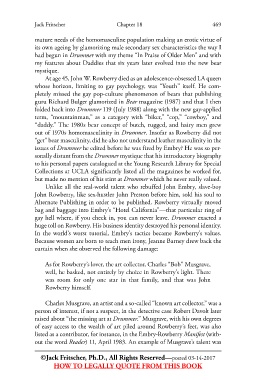Page 487 - Gay Pioneers: How DRUMMER Magazine Shaped Gay Popular Culture 1965-1999
P. 487
Jack Fritscher Chapter 18 469
mature needs of the homomasculine population making an erotic virtue of
its own ageing by glamorizing male secondary sex characteristics the way I
had begun in Drummer with my theme “In Praise of Older Men” and with
my features about Daddies that six years later evolved into the new bear
mystique.
At age 45, John W. Rowberry died as an adolescence-obsessed LA queen
whose horizon, limiting to gay psychology, was “Youth” itself. He com-
pletely missed the gay pop-culture phenomenon of bears that publishing
guru Richard Bulger glamorized in Bear magazine (1987) and that I then
folded back into Drummer 119 (July 1988) along with the new gay-applied
term, “mountainman,” as a category with “biker,” “cop,” “cowboy,” and
“daddy.” The 1980s bear concept of butch, rugged, and hairy men grew
out of 1970s homomasculinity in Drummer. Insofar as Rowberry did not
“get” bear masculinity, did he also not understand leather masculinity in the
issues of Drummer he edited before he was fired by Embry? He was so per-
sonally distant from the Drummer mystique that his introductory biography
to his personal papers catalogued at the Young Research Library for Special
Collections at UCLA significantly listed all the magazines he worked for,
but made no mention of his stint at Drummer which he never really valued.
Unlike all the real-world talent who rebuffed John Embry, slave-boy
John Rowberry, like sex-hustler John Preston before him, sold his soul to
Alternate Publishing in order to be published. Rowberry virtually moved
bag and baggage into Embry’s “Hotel California”—that particular ring of
gay hell where, if you check in, you can never leave. Drummer exacted a
huge toll on Rowberry. His business identity destroyed his personal identity.
In the world’s worst tutorial, Embry’s tactics became Rowberry’s values.
Because women are born to teach men irony, Jeanne Barney drew back the
curtain when she observed the following damage:
As for Rowberry’s lover, the art collector, Charles “Bob” Musgrave,
well, he basked, not entirely by choice in Rowberry’s light. There
was room for only one star in that family, and that was John
Rowberry himself.
Charles Musgrave, an artist and a so-called “known art collector,” was a
person of interest, if not a suspect, in the detective case Robert Davolt later
raised about “the missing art at Drummer.” Musgrave, with his own degrees
of easy access to the wealth of art piled around Rowberry’s feet, was also
listed as a contributor, for instance, in the Embry-Rowberry Manifest (with-
out the word Reader) 11, April 1983. An example of Musgrave’s talent was
©Jack Fritscher, Ph.D., All Rights Reserved—posted 03-14-2017
HOW TO LEGALLY QUOTE FROM THIS BOOK

